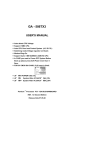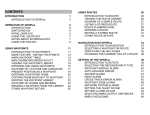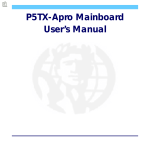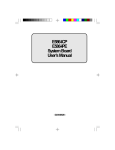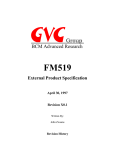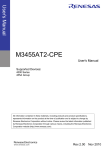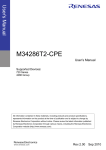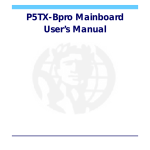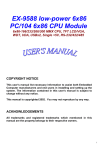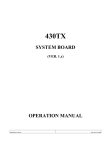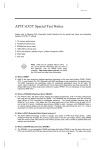Download GA - 586DX - Motherboards.org
Transcript
GA - 586DX USER'S MANUAL Dual PENTIUM PCI - ISA BUS MAINBOARD REV. 1 Third Edition GA-586DX The author assumes no responsibility for any errors or omissions which may appear in this document nor does it make a commitment to update the information contained herein. IBM PC/AT, PC/XT are trademarks of International Business Machine Corporation. PENTIUM is a trademark of Intel Corporation. AWARD is a trademark of Award Software, Inc. MS-DOS WINDOWS NT are registered trademarks of Microsoft Corporation. UNIX is a trademark of Bell Laboratories. OCTOBER 01, 1996 Taipei, Taiwan TABLE OF CONTENTS 2 Table of Contents 1. INTRODUCTION.................................................................................. 1-1 1.1. PREFACE ......................................................................................... 1-1 1.2. KEY FEATURES ............................................................................... 1-1 1.3. PERFORMANCE LIST....................................................................... 1-2 1.4. BLOCK DIAGRAM............................................................................. 1-3 1.5. INTRODUCE THE PCI - BUS............................................................. 1-4 1.6. FEATURES ....................................................................................... 1-4 2. SPECIFICATION.................................................................................. 2-1 2.1. HARDWARE ..................................................................................... 2-1 2.2. SOFTWARE...................................................................................... 2-2 2.3. ENVIRONMENT ................................................................................ 2-2 3. HARDWARE INSTALLATION............................................................... 3-1 3.1. UNPACKING..................................................................................... 3-1 3.2. MAINBOARD LAYOUT ...................................................................... 3-2 3.3. QUICK REFERENCE FOR JUMPERS & CONNECTORS................... 3-2 3.4. DRAM INSTALLATION ...................................................................... 3-4 3.5. CPU INSTALLATION AND JUMPERS SETUP ................................... 3-5 3.5.1 Uni-Processor Installation ........................................................... 3-5 3.5.2 Dual-Processor Installation ......................................................... 3-5 3.6. CMOS RTC & ISA CFG CMOS SRAM ............................................... 3-6 3.7. SPEAKER CONNECTOR INSTALLATION ......................................... 3-6 3.8. POWER LED & KEY LOCK CONNECTOR INSTALLATION ............... 3-7 3.9. HARDWARE RESET SWITCH CONNECTOR INSTALLATION........... 3-7 3.10. GREEN FUNCTION INSTALLATION ............................................... 3-7 3.11. ATAPI DEVICE INSTALLATION....................................................... 3-7 3.12. SCSI DEVICE INSTALLATION......................................................... 3-7 3.13. PERIPHERAL DEVICE INSTALLATION........................................... 3-10 3.14. KEYBOARD & PS/2 MOUSE INSTALLATION .................................. 3-10 3.15. KEYBOARD SETTING FUNCTION .................................................. 3-10 4. BIOS CONFIGURATION ...................................................................... 4-1 4.1. ENTERING SETUP ........................................................................... 4-1 4.2. CONTROL KEYS .............................................................................. 4-2 3 GA-586DX 4.3. GETTING HELP ................................................................................ 4-3 4.3.1. Main Menu.................................................................................. 4-3 4.3.2. Status Page Setup Menu / Option Page Setup Menu.................... 4-3 4.4. THE MAIN MENU.............................................................................. 4-3 4.5. STANDARD CMOS SETUP MENU .................................................... 4-5 4.6. BIOS FEATURES SETUP.................................................................. 4-9 4.7. CHIPSET FEATURES SETUP ........................................................... 4-13 4.8. POWER MANAGEMENT SETUP....................................................... 4-14 4.9. PNP/PCI CONFIGURATION .............................................................. 4-16 4.10. INTEGRATED PERIPHERALS......................................................... 4-17 4.11. LOAD SETUP DEFAULTS............................................................... 4-20 4.12. USER PASSWORD ......................................................................... 4-21 4.13. IDE HDD AUTO DETECTION .......................................................... 4-22 4.14. SAVE & EXIT SETUP ...................................................................... 4-23 4.15. EXIT WITHOUT SAVING ................................................................. 4-24 5. AT TECHNICAL INFORMATION .......................................................... 5-1 5.1. I/O BUS CONNECTOR PIN OUT ....................................................... 5-1 5.1.1. ISA SLOT PIN OUT .................................................................... 5-1 5.1.2. PCI - BUS SLOT PIN OUT .......................................................... 5-2 5.2. I/O & MEMORY MAP......................................................................... 5-3 5.3. TIMER & DMA CHANNELS MAP ....................................................... 5-3 5.4. INTERRUPT MAP ............................................................................. 5-4 5.5. RTC & CMOS RAM MAP................................................................... 5-5 APPENDIX A: POST MESSAGE ................................................................. A-1 APPENDIX B: POST CODES...................................................................... B-1 APPENDIX C: BIOS DEFAULT DRIVE TABLE ............................................ C-1 APPENDIX D: PROBLEM SHEET ............................................................... D-1 4 Introduction 1. INTRODUCTION 1.1. PREFACE Welcome to use the GA - 586DX motherboard. The motherboard is a 512 KB cache Dual PENTIUM Processor based PC / AT compatible system with ISA bus and PCI Local Bus, and has been designed to be the fastest PC / AT system. There are some new features allow you to operate the system with just the performance you want. This manual also explains how to install the motherboard for operation, and how to set up your CMOS CONFIGURATION with BIOS SETUP program. 1.2. KEY FEATURES q Intel Dual Pentium Processor based PC / AT compatible mainboard. q Supports Pentium processor,PODP running at 75-200 MHz, Cyrix 6x86, and AMD 5k86 Processor. q 4 Master / Slave PCI Bus slots, 4 ISA Bus slots. q Supports Dual 321 Pins (Socket 7) ZIF socket on board for Intel Processor, and Dual POWER (2.8V/3.3V) Processor. q Supports 512 KB Pipeline Burst Sync. 2nd Cache. q CPU L1 / L2 Write-Back cache operation. q Supports 8 - 512 MB DRAM memory on board. q Supports Adaptec Ultra & Wide SCSI ports for 15 SCSI Device. q Supports Adaptec RAID Port on board (Ver.3X and above version). q Supports 2 channels Enhance PCI IDE ports for 4 IDE Device. q Supports 2xCOM (16550), 1xLPT (EPP / ECP), 1x1.44MB Floppy port. q Supports Green function, Plug & Play function. q Licensed AWARD BIOS, FLASH EEPROM for BIOS update. q BENCHMARQ3287 / DALLAS 12887 / ODIN 12C887 RTC on board. q ATX form factor, 6 layers PCB. 1.3. PERFORMANCE LIST 1-1 GA-586DX The following performance data list is the testing results of some popular benchmark testing programs. These data are just referred by users, and there is no responsibility for different testing data values gotten by users. (The different Hardware & Software configuration will result in different benchmark testing results.) • CPU • DRAM • CACHE SIZE • DISPLAY • STORAGE Pentium processor 200 MHz 32 MB EDO 512 KB Pipeline Burst SRAM Matrox Millennium 2MB Onboard IDE port + Quantum FB 1280AT IDE Dirve Onboard SCSI port + Quantum XP 32150W SCSI Drive MS DOS V6.22 • O.S. ×DOSØ Program Item Unit IDE SCSI LandMark Speed CPU MHz 1157.16 1157.16 FPU MHz 3355.77 3355.80 V2.0 VIDEO chr/ms Norton System Info. CPU Index 635.3 V8.0 Disk Index 22.1 Core Test DATA Transfer Rate KB/S 14992 17072 Sequential Read KB/S 6288 7168 V.3.02 Random Read KB/S 2432 2336 PC BenchMark DOS Mark Index 1321.61 1796.00 CPU Mark16 Index 406.19 406.55 Video Score Index 6351.57 6368.49 Disk Score Index 673.64 1172.86 V9.0 16384 16384 635.3 16.6 × WINDOWSØ− with Display Driver at 1024 x 768 x 256 colors x 70Hz Program Item Unit Winbench 96 CPU Mark16 index CPU Mark32 index 411 408 Disk Winmark95 KB/s 1370 1340 Graphics Winmark95 Mpixels/S Winstone96 Index Winstone 96 1-2 IDE 390 SCSI 397 21.3 21.3 101.6 101.7 Introduction 1.4. BLOCK DIAGRAM Pentium R Host Bus Processor 3.3V Control Address Data Second Level Cache Addr Cntl Cache (SRAM) Tag Data Tag Cntl TIO[7:0] TXC ECC Main Memory (DRAM) Cntl TIO[10:8] PCI Bus Control Address/Data Ultra SCSI Hard Disk PCI Fast IDE CD ROM PIIX3 AIC-7880 Ultra Wide SCSI Device(s) ISA Device(s) Adaptec RAID Port ISA Bus 1.5. INTRODUCE THE PCI - BUS 1-3 GA-586DX Connecting devices to a CPU local bus can dramatically increase the speed of I/O-bound peripherals with only a slight increase in cost over traditional systems. This price / performance point has created a vast market potential for local bus products. The main barrier to this market has been the lack of an accepted standard for local bus peripherals. Many mainboard and chipset manufactures developed their own local bus implementations, but they are incompatible with each other. The VL (Video Electronics Standards Association) local bus and PCI (Peripheral Component Interconnect) bus specification was created to end this confusion. The PCI - bus standard, under development since Jun. 1992, which is designed to bring workstation-level performance to standard PC platform. The PCI - bus removes many of the bottlenecks that have hampered PC for several years. On the PCI - bus, peripherals operate at the native speed of the computer system, thus enabling data transfer between peripherals and the system at maximum speed. This performance is critical for bandwidth-constrained devices such as video, multimedia, mass storage, and networking adapters. PCI - bus standard provides end-users with a low-cost, extendible and portable local bus design, which will allow system and peripherals from different manufactures to work together. 1.6. FEATURES q 32 bits bus transfer mode. q Bus Master or Slave access. q Memory burst transfer to 132 MB/sec. q 33 MHz operation speed. q 10 device loading ability. q CPU independent. 1-4 Specification 2. SPECIFICATION 2.1. HARDWARE • CPU − Pentium processor 75 - 200 MHz, P55C (Dual). − Pentium OverDrive processor, (PODP). − AMD5K86, Cyrix6x86 processor. − Two 321 pins (socket 7) ZIF white socket on board. − 3.3V / 2.8V Dual Power Ready for P55C,Cyrix & AMD processor. • COPROCESSOR • SPEED − Included in Pentium. − 50 / 55 / 60 / 66 MHz system speed. − 25 / 27.5 / 30 / 33 PCI-Bus speed. − 7.5 / 8 MHz AT bus speed. − Hardware and Software speed switchable function. • DRAM MEMORY − 2 banks 72 pins SIMM module socket on board. − Use 4 / 8 / 16 / 32 / 64 /128 MB 60~70 ns SIMM module DRAM. − 8 ~ 512 MB DRAM size. − Support Fast Page / EDO DRAM access mode. • CACHE MEMORY − 16 KB cache memory included in Pentium. − 512 KB Pipeline Burst 2nd cache. − Support Write Back cache function for both CPU & on board cache. • SCSI PORTS − Using Adaptec 7880 Ultra Wide chipset. − Supports one SCSI-2 or SCSI-3 (Ultra) port. − Support one Wide or Ultra Wide port. − Support Adaptec RAID Port on board. • I/O BUS SLOTS − 4 Master / Slave PCI-BUS. − 4 16 bits ISA BUS. • IDE PORTS − 2 Enhanced IDE channels on board. (Using IRQ14,15) 2-1 GA-586DX − Support Mode 3,4 IDE & ATAPI CD - ROM. • I/O PORTS − Supports 2 16550 COM ports. (Using IRQ4, 3) − Supports 1 EPP/ECP LPT port. (Using IRQ7 or 5 and DMA3 or 1) − Supports 1 1.44MB Floppy port. (Using DMA2 & IRQ6) − Supports PS/2 Mouse. (Using IRQ12 ) − Supports PS/2 Keyboard. • GREEN FUNCTION − Standby & Suspend mode support. − Green switch & LED support. − IDE & Display power down support. − Monitor all IRQ / DMA / Display / I/O events. • BIOS − 128KB FLASH EEPROM. − Supports Plug & Play Function. • DIMENSION − ATX Form Factor, 6 layers PCB. 2.2. SOFTWARE • BIOS • O.S. − Licensed AWARD BIOS. − AT CMOS Setup, BIOS / Chipset Setup, Green Setup, Hard Disk Utility included. − Operation with MS-DOS, Windows95, WINDOWS NT, OS/2, NOVELL and SCO UNIX. 2.3. ENVIRONMENT • Ambient Temp. • Relative Hum. • Altitude • Vibration • Electricity − − − − − − 0°C to +50°C (Operating). 0 to +85% (Operating). 0 to 10,000 feet (Operating). 0 to 1,000 Hz. 4.9 V to 5.2 V. 5 A to 7 A current. 2-2 Hardware Installation 3. HARDWARE INSTALLATION 3.1. UNPACKING The mainboard package should contain the following: • The GA - 586DX mainboard. • USER'S MANUAL for mainboard & SCSI Driver Installation. • Cable set for IDE, Floppy & SCSI device. • Diskette for BUS MASTE IDE Driver & SCSI controller Drivers. The mainboard contains sensitive electric components which can be easily damaged by static electricity, so the mainboard should be left in its original packing until it is installed. Unpacking and installation should be done on a grounded anti-static mat. The operator should be wearing an anti static wristband, grounded at the same point as the anti-static mat. Inspect the mainboard carton for obvious damage. Shipping and handling may cause damage to your board. Be sure there are no shipping and handling damages on the board before proceeding. After opening the mainboard carton, extract the system board and place it only on a grounded anti-static surface component side up. Again inspect the board for damage. Press down on all of the socket IC's to make sure that they are properly seated. Do this only on with the board placed on a firm flat surface. M DO NOT APPLY POWER TO THE BOARD IF IT HAS BEEN DAMAGED. You are now ready to install your mainboard. The mounting hole pattern on the mainboard matches the IBM-AT system board. It is assumed that the chassis is designed for a standard IBM XT/AT mainboard mounting. Place the chassis on the anti-static mat and remove the cover. Take the plastic clips, Nylon stand-off and screws for mounting the system board, and keep them separate. 3.2. MAINBOARD LAYOUT 3-1 GA-586DX CN1 COMB LPT PCI3 PCI1 CN3 1 +12V GND PCI2 1 J2:CPU FAN DRAM Bank0,1 SCSI RAID 1 2 3 4 Port ON S1 OFF DIP SWITCH 1st CPU U7 CN7 2nd CPU Socket U10 P.B. WIDE SCSI ULTRA SCSI GA-586DX CN10 J3 J4 11 J5 1 + J6 1 + J7 J8 1 J9 IDE 1st CN11 CN8 CN9 P.B. SRAM IDE 2nd + ×Figure 3.1Ø 3.3. QUICK REFERENCE FOR JUMPERS & CONNECTORS t t t t J1,2: CPU cooling FAN Power Connector 1 +12V 2 GND J3: SPEKER Connector Pin No. 1 VCC 2 NC. 3 NC. 4 Output Function J4: RESET Switch (RST) Pin No. 1 RESET Input 2 GND Function J5: POWER ON LED (PW-LED) Pin No. Function 3-2 CN5 FLOPPY SRAM JP15 COMA Socket J1:CPU FAN AIC-7880 CN4 POWER CONN. +12V GND PCI4 Mouse Keyboard CN2 CN6 Hardware Installation 1 2 3 t LED POWER (+) NC GND (-) J6: Hard Disk active LED Pin No. 1 LED POWER (+) 2 LED POWER (-) 3 LED POWER (-) 4 LED POWER (+) Function t J7: INFARED Connector (IR) -- Function Option Pin No. Function 1 IR Data Output 2 GND 3 IR Data Input 4 NC 5 POWER (+) t J8: GN-SW Pin No. Function Close Force system to enter Green Mode (Suspend mode). Open Normal Operation. t J9: GN-LED Pin No. 1 LED anode (+). 2 LED cathode (-). Function t S1: System Speed Selection 1 2 Function ON ON For 50 MHz system speed ( CPU 75, 100(x2), PODP 125 MHz ). ON OFF For 60 MHz system speed ( CPU 90, 120, 150, 180 MHz ). OFF ON For 66 MHz system speed ( CPU 100, 133, 166, 200 MHz ). OFF OFF For 55 MHz system speed ( CPU 110 MHz ). t S1: CPU INT. / EXT. FREQ. RATIO 3 4 OFF OFF x 1.5 OFF ON x2 ON ON x 2.5 ON OFF x3 t JP15: Wide SCSI port High Byte Terminator ON/OFF Pin No. Function Open High Byte Terminator always Enable (ON). Close High Byte Terminator ON/OFF control by software. 3-3 GA-586DX t CN1-11 I/O Ports Connector CN1 For Serial port2 (COM B). CN2 For LPT port. CN3 For Keyboard I/O port. CN4 For PS/2 Mouse port. CN5 For Serial port1(COM A). CN6 USB port (option). CN7 For Floppy port CN8 For ULTRA WIDE SCSI port. CN9 For ULTRA 8 bit SCSI port. CN10 For Secondary IDE port. CN11 For Primary IDE port. t Power Connector Pin No. 1 Power Good signal 2,10,11,12 VCC (+5V) 3 +12V 4 -12V 5,6,7,8 GND 9 -5V Function t Adaptec RAID Port The port is for Adaptec PCI RAID Port card ARO-113X, just Plug & Play will Enable onboard SCSI controller to perform as SCSI RAID channels. 3.4. DRAM INSTALLATION The mainboard can be installed with 4 / 8 / 16 / 32 / 64 / 128 MB 72 pins SIMM module DRAM, and the DRAM speed must be 60 or 70 ns. The DRAM memory system on mainboard consists of bank 0 & bank 1. Each bank consist of 2 PCs 72 pins SIMM module DRAM. Because the 72 pins SIMM module is 32 bits width, using 2 PCs which can match a 64 bits system. The total memory size is 8 - 512 MB, and various configuration of DRAM types in the following TABLE are for reference: Bank0 Bank1 Single: Single bank SIMM Module Single None Ex. 4MB, 16MB, 64MB Single Single Single Double Double: Double banks SIMM Module Double None Ex. 8MB, 32MB, 128MB 3-4 Hardware Installation Double Double Single Double The DRAM installation position refer to Figure 3.1, and notice the Pin 1 of SIMM module must match with the Pin 1 of SIMM socket when the DRAM SIMM module is installed. Insert the DRAM SIMM module into the SIMM socket at 45 degree angle. If there is a wrong direction of Pin 1, the DRAM SIMM module couldn't be inserted into socket completely. After completely insert SIMM module into socket, then press the SIMM module in vertical direction until the left and right metal holders can keep the SIMM module standing up con-firmly. 3.5. CPU INSTALLATION AND JUMPERS SETUP 3.5.1 Uni-Processor Installation The system's speed depends on the frequency of CLOCK GENERATOR. The user can change the DIP SWITCH (S1) selection to set up the system speed to 50 MHz, 55 MHz, 60 MHz or 66 MHz for 75 - 200 MHz processor. The mainboard can use Intel Pentium Processor, P55C or PODP ( Pentium OverDrive Processor - P54CT, P54CTB), Cyrix 6x86 AND AMD 5k86 processor. The CPU speed must match with the frequency of CLOCK GEN. It will cause system hanging up if the CLOCK GEN.'S frequency is higher than CPU's. There are two CPU socket onboard, the user can install CPU to any one socket, but 1st CPU socket is recommanded for one processor configuration. 3.5.2 Dual-Processor Installation The mainboard provide Intel Multi-processor specification, so only Intel Pentium Processor can be used when Dual Processor configuration is achieved. The two processor must used same speed and same type (Ex. P54C or P55C). CPU Installation Table: DIP SWITCH (S1) 1 2 3 4 ON ON OFF OFF ON OFF OFF OFF EXT. CLK. RATIO INT.CLK. CPU SPEED MHz MHz 1.5 50 75 PENTIUM 75 MHz, AMD5K86-P75 1.5 60 90 PENTIUM 90 MHz, AMD5K86-P90/P120 3-5 GA-586DX OFF ON OFF OFF 1.5 66 100 PENTIUM 100 MHz, AMD5K86-P100/P133 ON ON OFF ON 2 50 100 Cyrix 6X86-P120 OFF OFF OFF ON 2 55 110 Cyrix 6X86-P133 ON OFF OFF ON 2 60 120 PENTIUM 120 MHz, AMD5K86-P150, Cyrix 6X86-P150 OFF ON OFF ON 2 66 133 PENTIUM 133 MHz, AMD5K86-P166, Cyrix 6X86-P166 ON ON ON ON 2.5 50 125 Intel PODP 125MHz ON OFF ON ON 2.5 60 150 PENTIUM 150 MHz OFF ON ON ON 2.5 66 166 PENTIUM 166 MHz ON OFF ON OFF 3 60 180 PENTIUM 180 MHz OFF ON ON OFF 3 66 200 PENTIUM 200 MHz M The CPU is a sensitive electric component and it can be easily damaged by static electricity, so users must keep it away from metal surface when the CPU is installed onto mainboard. 3.6. CMOS RTC & ISA CFG CMOS SRAM There're RTC & CMOS SRAM on board, they have a power supply from internal battery to keep the DATA inviolate & effective. The RTC is a REAL-TIME CLOCK device which provides the DATE & TIME to system. The CMOS SRAM is used for keeping the information of ISA device system configuration, so the system can automatically boot OS. every time. Due to the life-time of RTC internal battery is 5 years, the user can change a new RTC to replace old one after it can not work. The new one's brand and type must be same with old one. 3.7. SPEAKER CONNECTOR INSTALLATION There is always a speaker in AT system for sound purpose. The 4 - Pins connector J3 is used to connect speaker. The speaker can work well in both direction of connector when it is installed to the connector J3 on mainboard. 3.8. POWER LED & KEY LOCK CONNECTOR INSTALLATION There are a system power LED lamp on the panel of case. The power LED will light on when system is powered-on, which is connected to a 3 PIN connector. The connector should be connected to J5 of mainboard in correct direction. 3.9. HARDWARE RESET SWITCH CONNECTOR INSTALLATION 3-6 Hardware Installation The RESET switch on panel provides users with HARDWARE RESET function which is almost the same as power-on/off. The system will do a cold start after the RESET switch is pushed and released by user. The RESET switch is a 2 PIN connector and should be installed to J4 on mainboard. 3.10. GREEN FUNCTION INSTALLATION For the purpose of power saving, there are two jumpers, J8 and J9, to make sure the power saving function doing well. The J9 is a indicator (green LED) for green function. If the green LED is ON, the system is operating in green mode. The J8 is a switch to force the system get into green mode immediately. 3.11. ATAPI DEVICE INSTALLATION There are two Enhance PCI IDE ports (CN10,11) on board, which following ATAPI standard SPEC. Any one IDE port can connecte to two ATAPI devices (IDE Hard Disk, CD-ROM & Tape Driver), so total four ATAPI devices can exist in a system. The booting Hard Disk should be the Master device of 1st IDE channel. 3.12. SCSI DEVICE INSTALLATION There are two SCSI ports on board, One is 8bit SCSI port for SCSI-2 or ULTRA SCSI device, and total 7 8bit SCSI devices can exist in a system. The other is 16bit SCSI port for wide or ULTRA Wide SCSI device, and total 15 SCSI devices (include 8bit SCSI device) can exist in a system. The low byte Terminator (used for 8bit SCSI port) turning "ON" or "OFF" is controled by software (SCSI BIOS SETUP Utility), and High byte Terminaator (used for Wide SCSI port) turning ON or OFF can be controled by JP15 as following:JP15 OPEN: High byte Terminator is always enable (ON) JP15 CLOSE:High byte Terminator is controled by software SCSI BIOS SETUP (same status as Low byte Terminator). Terminator ON/OFF rules CASE 1: High byte-ON (JP15 OPEN) Low byte-ON (SCSI BIOS SETUP Enabled) 3-7 GA-586DX 1 System has 16 bit SCSI 16 bit SCSI DEVICE 16 bit SCSI DEVICE SCSI ID SCSI ID No.15 No.0 Mainboard Terminator ON Terminator OFF 2 System has only 8 bit SCSI device 8 bit SCSI DEVICE Terminator ON 8 bit SCSI DEVICE SCSI ID SCSI ID No.6 No.0 Mainboard Terminator ON Terminator ON 3 Terminator OFF System has EXT. SCSI port but has not INT. SCSI device EXT. 50pin or 68pin SCSI port EXT. SCSI Terminator EXT. SCSI DEVICE Terminator ON Mainboard EXT. SCSI port Terminator ON CASE 2:High byte-ON(JP15 OPEN), Low byte-OFF(SCSI BIOS SETUP Disabled) 1 System has 16 bit & 8 bit SCSI device 16 bit SCSI DEVICE 16 bit SCSI DEVICE 8 bit SCSI DEVICE 8 bit SCSI DEVICE Terminator OFF Terminator ON Mainboard Terminator ON Terminator OFF High byte Terminator ON Low byte Terminator OFF 3-8 Hardware Installation 2 System has 8 bit EXT. SCSI port & 8 bit INT. SCSI device SCSI-2 Terminator EXT. SCSI-2 DEVICE Terminator ON 3 8 bit 8 bit SCSI DEVICE SCSI DEVICE SCSI ID SCSI ID No.6 No.0 Terminator OFF Terminator ON Mainboard High byte Terminator ON Low byte Terminator OFF System has 8 bit EXT. SCSI port & 16 bit INT. SCSI device SCSI-2 Terminator EXT. SCSI-2 DEVICE Terminator ON 4 EXT. 50pin SCSI port EXT. 50pin SCSI port Mainboard High byte Terminator ON Low byte Terminator OFF 16 bit 16 bit SCSI DEVICE SCSI DEVICE SCSI ID SCSI ID No.15 No.0 Terminator OFF Terminator ON 8 bit SCSI DEVICE 8 bit SCSI DEVICE SCSI ID SCSI ID No.6 No.0 Terminator OFF Terminator ON System has 16 bit EXT. SCSI port & 8 bit INT. SCSI device WIDE SCSI Terminator EXT. WIDE SCSI DEVICE Terminator ON EXT. 50pin SCSI port Mainboard High byte Terminator ON Low byte Terminator OFF CASE 3: High byte-OFF (JP15 CLOSE) Low byte-OFF (SCSI BIOS SETUP Disabled) 1 System has 16 bit EXT. SCSI port & INT. 16 bit SCSI device WIDE SCSI Terminator EXT. WIDE SCSI DEVICE Terminator ON EXT. 68pin SCSI port Mainboard High byte Terminator OFF Low byte Terminator OFF 3-9 16 bit SCSI DEVICE 16 bit SCSI DEVICE SCSI ID SCSI ID No.15 No.0 Terminator OFF Terminator ON GA-586DX 3.13. PERIPHERAL DEVICE INSTALLATION After the I/O device installation and jumpers setup, the mainboard can be mounted into the case and fixed by screw. To complete the mainboard installation, the peripheral device could be installed now. The basic system needs a display interface card. If the PCI - Bus device is to be installed in the system, any one of four PCI Bus slots can be used if Slave PCI - Bus device being installed; any one of tree PCI-Bus slots (PCI1-PCI3) can be used if Bus Master PCI-Bus device being installed (PCI4 slot can only support Slave PCI-Bus device due to onboard SCSI controller using PCI4 slot's Master resource). 3.14. KEYBOARD & PS/2 MOUSE INSTALLATION The main board supports PS/2 connector type keyboard & Mouse. The BIOS will auto detect wheather the PS/2 Mouse is installed or nor & assign IRQ12 for Mouse port if which was installed. After installing the peripheral device, the user should check everything again, and prepare to power-on the system. 3.15. KEYBOARD SETTING FUNCTION After booting the O.S., there are some special functions used by keyboard as follows: "CTRL_ALT_DEL" − Pressing these keys simultaneously will cause system to Warm Start (Software Reset). 3-10 BIOS Configuration 4. BIOS CONFIGURATION Award's BIOS ROM has a built-in Setup program that allows users to modify the basic system configuration. This type of information is stored in battery-backed CMOS SRAM so that it retains the Setup information when the power is turned off. 4.1. ENTERING SETUP Power ON the computer and press <Del> immediately will allow you to enter Setup. The other way to enter Setup is to power on the computer, when the below message appears briefly at the bottom of the screen during the POST (Power On Self Test), press <Del> key or simultaneously press <Ctrl>, <Alt>, and <Esc> keys. Ÿ TO ENTER SETUP BEFORE BOOT PRESS CTRL-ALT-ESC OR DEL KEY If the message disappears before you respond and you still wish to enter Setup, restart the system to try again by turning it OFF then ON or pressing the "RESET" bottom on the system case. You may also restart by simultaneously press <Ctrl>,<Alt>, and <Del> keys. If you do not press the keys at the correct time and the system does not boot, an error message will be displayed and you will again be asked to, Ÿ PRESS F1 TO CONTINUE, CTRL-ALT-ESC OR DEL TO ENTER SETUP 4-1 GA-586DX 4.2. CONTROL KEYS Up arrow Move to previous item Down arrow Move to next item Left arrow Move to the item in the left hand Right arrow Move to the item in the right hand Esc key Main Menu - Quit and not save changes into CMOS Status Page Setup Menu and Option Page Setup Menu - Exit current page and return to Main Menu PgUp key Increase the numeric value or make changes PgDn key Decrease the numeric value or make changes F1 key General help, only for Status Page Setup Menu and Option Page Setup Menu F2 key Change color from total 16 colors F3 key Calendar, only for Status Page Setup Menu F4 key Reserved F5 key Restore the previous CMOS value from CMOS, only for Option Page Setup Menu F6 key Load the default CMOS value from BIOS default table, only for Option Page Setup Menu F7 key Load the default F8 key Reserved F9 key Reserved F10 key Save all the CMOS changes, only for Main Menu 4-2 BIOS Configuration 4.3. GETTING HELP 4.3.1. Main Menu The on-line description of the highlighted setup function is displayed at the bottom of the screen. 4.3.2. Status Page Setup Menu / Option Page Setup Menu Press F1 to pop up a small help window that describes the appropriate keys to use and the possible selections for the highlighted item. To exit the Help Window press <Esc>. 4.4. THE MAIN MENU Once you enter Award BIOS CMOS Setup Utility, the Main Menu (Figure 4.1) will appear on the screen. The Main Menu allows you to select from seven setup functions and two exit choices. Use arrow keys to select among the items and press <Enter> to accept or enter the sub-menu. ROM PCI / ISA BIOS CMOS SETUP UTILITY AWARD SOFTWARE, INC. STANDARD CMOS SETUP USER PASSWORD BIOS FEATURES SETUP IDE HDD AUTO DETECTION CHIPSET FEATURES SETUP SAVE & EXIT SETUP POWER MANAGEMENT SETUP EXIT WITHOUT SAVING PNP/PCI CONFIGURATION INTEGRATED PERIPHERALS LOAD SETUP DEFAULTS ESC : Quit F10 : Save & Exit Setup : Select Item (Shift)F2 Time, Date, Hard Disk Type, ... • Figure 4.1: Main Menu Standard CMOS setup 4-3 : Chang Color GA-586DX This setup page includes all the items in a standard compatible BIOS. • BIOS features setup This setup page includes all the items of Award special enhanced features. • Chipset features setup This setup page includes all the items of chipset special features. • Power management setup This setup page includes all the items of Green function features. • PNP/PCI configuration This setup page includes all the configurations of PCI & PNP ISA resources. • Integrated peripherals This setup page includes all onboard peripherals. • Load setup defaults BIOS defaults indicates the most appropriate value of the system parameter which the system would be in safe configuration. • User password Change, set, or disable password. It allows you to limit access to the system and Setup, or just to Setup. • IDE HDD auto detection Automatically configure hard disk parameter. • Save & exit setup Save CMOS value changes to CMOS and exit setup. • Exit without save Abandon all CMOS value changes and exit setup. 4.5. STANDARD CMOS SETUP MENU The items in Standard CMOS Setup Menu (Figure 4.2) are divided into 9 4-4 BIOS Configuration categories. Each category includes no, one or more than one setup items. Use the arrows to highlight the item and then use the <PgUp> or <PgDn> keys to select the value you want in each item. ROM PCI / ISA BIOS STANDARD CMOS SETUP AWARD SOFTWARE, INC. Date (mm:dd:yy) : Mon, Feb 7 1994 Time (hh:mm:ss) : 10 : 45 : 38 HARD DISKS TYPE SIZE CYLS HEAD PRECOMP LANDZ SECTOR MODE Primary Master : Auto 0 0 0 0 0 0 Auto Primary Slave : None 0 0 0 0 0 0 --------- Secondary Master : None 0 0 0 0 0 0 --------- Secondary Slave : None 0 0 0 0 0 0 --------- Driver A : 1.44M , 3.5 inch. Driver B : None Floppy 3 Mode Support Video : Disabled : EGA/VGA Halt On : All Errors ESC : Quit F1 : Help Base Memory: 640 K Extended Memory: 15360 K Other Memory: 384 K Total Memory: 16384 K : Select Item (Shift)F2 PU/PD/+/- : Modify : Chang Color Figure 4.2: Standard CMOS Setup Menu • Date The date format is <day>, <date> <month> <year>. Press <F3> to show the calendar. day • date month year Time The day, from Sun to Sat, determined by the BIOS and is display-only The date, from 1 to 31 (or the maximum allowed in the month) The month, Jan. through Dec. The year, from 1900 through 2099 The time format in <hour> <minute> <second>. The time is calculated base on the 24-hour military-time clock. 4-5 GA-586DX For example, 1 p.m. is 13:00:00. • Primary HDDs / Secondary HDDs The category identify the types of hard disk drive C drive F 4 devices that has been installed in the computer. There are 45 pre-defined types and a user definable type. Type 1 to Type 45 are pre-defined. Type User is user-definable and type Auto will automatically detect HDD's type. Press PgUp or PgDn to select a numbered hard disk type or type the number and press <Enter>. Note that the specifications of your drive must match with the drive table. The hard disk will not work properly if you enter improper information for this category. If your hard disk drive type is not matched or listed, you can use Type User to define your own drive type manually. If you select Type User, related information is asked to be entered to the following items. Enter the information directly from the keyboard and press <Enter>. Those information should be provided in the documentation form your hard disk vendor or the system manufacturer. CYLS. HEADS PRECOMP LANDZONE SECTORS • number of cylinders number of heads write precomp landing zone number of sectors If a hard disk has not been installed select NONE and press <Enter>. Drive A type / Drive B type The category identify the types of floppy disk drive A or drive B that has been installed in the computer. None No floppy drive installed 4-6 BIOS Configuration • • 360K, 5.25 in. 5-1/4 inch PC-type standard drive; 360 kilobyte capacity. 1.2M, 5.25 in. 5-1/4 inch AT-type high-density drive; 1.2 megabyte capacity (3-1/2 inch when 3 Mode is Enabled). 720K, 3.5 in. 3-1/2 inch double-sided drive; 720 kilobyte capacity 1.44M, 3.5 in. 3-1/2 inch double-sided drive; 1.44 megabyte capacity. Floppy 3 Mode Support (for Janpan Area) Disable Normal Floppy Drive. Drive A Drive A is 3 mode Floppy Drive. Drive B Drive B is 3 mode Floppy Drive. Both Drive A & B are 3 mode Floppy Drive. Video The category detects the type of adapter used for the primary system monitor that must matches your video display card and monitor. Although secondary monitors are supported, you do not have to select the type in setup. EGA/VGA Enhanced Graphics Adapter/Video Graphics Array. For EGA, VGA, SVGA, or PGA monitor adapters • CGA 40 Color Graphics Adapter, power up in 40 column mode CGA 80 Color Graphics Adapter, power up in 80 column mode MONO Monochrome adapter, includes high resolution monochrome adapters Halt on The category determines whether the computer will stop if an error is detected during power up. NO errors All errors The system boot will not be stopped for any error that may be detected Whenever the BIOS detects a non-fatal error the 4-7 GA-586DX All,But Keyboard All, But Diskette All, But Disk/Key • system will be stopped and you will be prompted The system boot will not stop for a keyboard error; it will stop for all other errors The system boot will not stop for a disk error; it will stop for all other errors The system boot will not stop for a keyboard or disk error; it will stop for all other errors Memory The category is display-only which is determined by POST (Power On Self Test) of the BIOS. Base Memory The POST of the BIOS will determine the amount of base (or conventional) memory installed in the system. The value of the base memory is typically 512 K for systems with 512 K memory installed on the motherboard, or 640 K for systems with 640 K or more memory installed on the motherboard. Extended Memory The BIOS determines how much extended memory is present during the POST. This is the amount of memory located above 1 MB in the CPU's memory address map. Expanded Memory Expanded Memory in memory defined by the Lotus/Intel / Microsoft (LIM) standard as EMS. Many standard DOS applications can not utilize memory above 640 K, the Expanded Memory Specification (EMS) swaps memory which not utilized by DOS with a section, or frame, so these applications can access all of the system memory. Memory can be swapped by EMS is usually 64 K within 1 MB or memory above 1 MB, depends on the chipset design. Expanded memory device driver is required to use memory as Expanded Memory. 4-8 BIOS Configuration Other Memory This refers to the memory located in the 640 K to 1024 K address space. This is memory that can be used for different applications. DOS uses this area to load device drivers to keep as much base memory free for application programs. Most use for this area is Shadow RAM. 4.6. BIOS FEATURES SETUP ROM PCI / ISA BIOS BIOS FEATURES SETUP AWARD SOFTWARE, INC. • Virus Warning : Disabled Video BIOS Shadow : Enabled CPU Internal Cache : Enabled External Cache Quick Power On Self Test : Enabled : Enabled C8000 - CBFFF Shadow CC000 - CFFFF Shadow : Disabled : Disabled Boot Sequence Swap Floppy Drive : A, C : Disabled D0000 - D3FFF Shadow D4000 - D7FFF Shadow : Disabled : Disabled Boot Up Floppy Seek Boot Up NumLock Status Typematic Rate Setting Typematic Rate (Chars/Sec) Typematic Delay (Msec) : Enabled : On : Disabled :6 :250 D8000 - DBFFF Shadow DC000 - DFFFF Shadow : Disabled : Disabled Security Option PCI/VGA Palette Snoop MP SPEC. For Single CPU OS Select For DRAM >64MB : Setup : Disabled : Enabled : Non-OS2 ESC F1 F5 F7 : Quit PU/PD/+/: Help : Old Values (Shift)F2 : Select Item : Modify : Color : Load Setup Defaults Figure 4.3: BIOS Features Setup Virus Warning This category flashes on the screen. During and after the system boots up, any attempt to write to the boot sector or partition table of the hard disk drive will halt the system and the following error message will appear, in the mean time, you can run antivirus program to locate the problem. Default value is Disabled. Enabled Activate automatically when the system boots up causing a warning message to appear when anything attempts to 4-9 GA-586DX Disabled • access the boot sector or hard disk partition table No warning message to appear when anything attempts to access the boot sector or hard disk partition table CPU Internal Cache / External Cache These two categories speed up memory access. However, it depends on CPU / chipset design. The default value is Enabled. Enabled Disabled • Enable cache Disable cache Quick Power On Self Test This category speeds up Power On Self Test (POST) after you power on the computer. If it is set to Enable, BIOS will shorten or skip some check items during POST. The default value is Enabled. Enabled Disabled • Enable quick POST Normal POST Boot Sequence This category determines which drive computer searches first for the disk operating system (i.e., DOS). Default value is A,C. • A,C System will first search for floppy disk drive then hard disk drive C,A System will first search for hard disk drive then floppy disk drive Swap Floppy Drive The default value is Disabled. Enabled Disabled • Floppy A & B will be swapped under DOS Floppy A & B will be normal definition Boot Up Floppy Seek During POST, BIOS will determine if the floppy disk drive installed is 40 or 80 tracks. 360 K type is 40 tracks while 720 K, 1.2 M and 1.44 M are all 80 tracks. The default value is Enabled. 4-10 BIOS Configuration Enabled Disabled • Boot Up NumLock Status The default value is On. On Off • Enable Keyboard typematic rate setting. Disable Keyboard typematic rate setting. Typematic Rate (Chars/Sec) The default value is 6. 6-30 • Keypad is number keys Keypad is arrow keys Typematic Rate Setting The default value is Disabled. Enabled Disabled • BIOS searches for floppy disk drive to determine if it is 40 or 80 tracks, Note that BIOS can not tell from 720 K, 1.2 M or 1.44 M drive type as they are all 80 tracks BIOS will not search for the type of floppy disk drive by track number. Note that there will not be any warning message if the drive installed is 360 K Set the maximum typematic rate from 6 chars. per second to 30 chars. per second. Typematic Delay (mSec) The default value is 250. 250-1000 • Set the time delay from first key to repeat the same key in to computer. Security Option This category allows you to limit access to the system and Setup, or just to Setup. The default value is Setup. System The system will not boot and access to Setup will be denied if the correct password is not entered at the prompt Setup The system will boot, but access to Setup will be denied if the correct password is not entered at the prompt M To disable security, select PASSWORD SETTING at Main Menu and then you will be asked to enter password. Do not type anything and just press <Enter>, it will disable security. Once the security is disabled, the system will boot and you can enter Setup freely. 4-11 GA-586DX • Video BIOS Shadow It determines whether video BIOS will copied to RAM, however, it is optional from chipset design. Video Shadow will increase the video speed. The default value is Enable. Enabled Disabled • Video shadow is enabled Video shadow is disabled PCI/VGA Palette Snoop The default value are Disabled. Enabled Disabled • For having Video Card on ISA Bus and Bus. For VGA Card only. VGA Card on PCI MP SPEC. Fpr Single CPU The default value are Enabled. Enabled The BIOS will Enabled Intel MP SPEC. for O.S. which support Intel MP SPEC. system if only one processor is installed. Disabled The BIOS will report standard AT system to O.S. if only one processor is installed. If two processor are installed, the BIOS always report MP SPEC. to O.S.. NOTE: Under some O.S. with standard AT system, the performance is better than the same O.S. with MP SPEC. system. • OS Select For DRAM>64MB The default value is Non-OS2. Non-OS2 Using non-OS2 operating system. OS2 Using OS2 operating system and DRAM>64MB. • C8000 - CFFFF Shadow / D0000 - DFFFF Shadow These categories determine whether optional ROM will be copied to RAM by 16 K byte. The default value are Disabled. Enabled Optional shadow is enabled Disabled Optional shadow is disabled 4.7. CHIPSET FEATURES SETUP 4-12 BIOS Configuration ROM PCI / ISA BIOS CHIPSET FEATURES SETUP AWARD SOFTWARE, INC. Auto Configuration : 60-70ns Memory Hole At 15M-16M : Disabled DRAM ECC/PARITY select Memory Parity/ECC Check : ECC : Disabled ESC : Quit F1 : Help F5 F7 : Select Item PU/PD/+/- : Old Values (Shift)F2 : Load Setup Defaults : Modify : Color Figure 4.4: Chipset Features Setup • Auto Configuration • The default value is 60~70ns. 60~70ns For 60~70ns DRAM Timing. 60ns For 60ns DRAM Timing. Memory Hole At 15M-16M The default value is Disabled. Disabled Normal Setting. Enabled Set Address=15~16MB remap to ISA BUS. • DRAM ECC/PARITY select The default value is ECC. ECC Enable ECC function when using 36 bit DRAM Module. PARITY Enable PARITY function when using 36 bit DRAM Module. • Memory Parity / ECC Check The default value is Disabled. Disabled Disable Memory Parity or ECC check function. Auto BIOS will automaticly detect whether 36 bit DRAM Module 4-13 GA-586DX Enabled being used, If yes, the BIOS will Enable the function. Enable Memory Parity or ECC check function. 4.8. POWER MANAGEMENT SETUP ROM PCI / ISA BIOS POWER MANAGEMENT SETUP AWARD SOFTWARE, INC. Power Management : Enabled PM Control by APM Video Off Method : Yes : DPMS ** Power Down & Resume Events ** IRQ3 (COM 2) : ON : ON IRQ4 (COM 1) Standby Mode : Disabled IRQ5 IRQ6 (LPT 2) (Floppy Disk) : OFF : ON Suspend Mode HDD Power Down : Disabled : Disabled IRQ7 IRQ8 (LPT 1) (RTC Alarm) : OFF : OFF IRQ9 (IRQ2 Redir) IRQ10 (Reserved) : OFF : OFF IRQ11 (Reserved) IRQ12 (PS/2 Mouse) : OFF : OFF IRQ14 (Hard Disk) IRQ15 (Reserved) : ON : OFF ESC : Quit F1 : Help F5 F7 • PU/PD/+/- : Old Values (Shift)F2 : Load Setup Defaults : Select Item : Modify : Color Figure 4.5: Power Management Setup Power Management The default value is Enabled. Enabled Enable Green function. Disabled Disable Green function. Please disable Green Function for Non-S CPU in OS/2, Unix, Window NT & Novell system. • PM Control by APM The default value is Yes. Yes Enable software APM function. No Disable software APM function. • Video off Method The default value is DPMS Support. V/H SYNC + Blank BIOS will turn off V/H-SYNC when gets into 4-14 BIOS Configuration Blank Screen DPMS Support • Green mode for Green monitor power saving. BIOS will only black monitor when gets into Green mode. BIOS will use DPMS Standard to control VGA card. (The Green type VGA card will turn of V/HSYNC automatically.) Standby Mode ( for Network Card using ) The default value is Disable. Disable Disable Standby Mode. 1 min - 1 Hour Setup the timer to enter Standby Mode. • Suspend mode ( for CPU stop clock Mode ) The default value is Disable. Disable Disable Suspend Mode. 1 min - 1 Hour Setup the timer to enter Suspend Mode. • HDD Power Down • The default value is Disable. Disable Disable HDD Power Down mode function. 1-15 mins Enable HDD enter Power Down mode between 1 to 15 mins. IRQX ( 3,4,5,6,7,9,10,11,12,14,15 ) The default value is On. On Off The system will return to normal mode from Green Mode when the IRQX is active. The system will not return to normal mode from Green Mode when the IRQX is active. 4.9. PNP/PCI CONFIGURATION 4-15 GA-586DX ROM PCI / ISA BIOS PNP/PCI CONFGURATION AWARD SOFTWARE, INC. Resources Controlled by Reset Configuration Data : Manual : Disabled IRQ-3 assigned to IRQ-4 assigned to IRQ-5 assigned to IRQ-7 assigned to IRQ-9 assigned to IRQ-10 assigned to IRQ-11 assigned to IRQ-12 assigned to IRQ-14 assigned to IRQ-15 assigned to DMA-0 assigned to DMA-1 assigned to DMA-3 assigned to DMA-5 assigned to DMA-6 assigned to DMA-7 assigned to : Legacy ISA : Legacy ISA : PCI/ISA PnP : Legacy ISA : PCI/ISA PnP : PCI/ISA PnP : PCI/ISA PnP : Legacy ISA : Legacy ISA : Legacy ISA : PCI/ISA PnP : PCI/ISA PnP : PCI/ISA PnP : PCI/ISA PnP : PCI/ISA PnP : PCI/ISA PnP ESC F1 F5 F7 : Quit PU/PD/+/: Help : Old Values (Shift)F2 : Load Setup Defaults : Select Item : Modify : Color Figure 4.6: PCI Slot Configuration • Resources Controlled by The default value is Manual. Manual Auto • User can set the PnP resourse (I/O Address, IRQ & DMA channels) used by legacy ISA DEVICE. BIOS automaticly use these PnP resoures. IRQ (3,4,5,7,9,10,11,12,14,15),DMA(0,1,3,5,6,7) assigned to The default value is "Legacy ISA" or "PCI/ISA PnP". Legacy ISA PCI/ISA PnP The resource is used by Legacy ISA device. The resource is used by PCI/ISA PnP device (PCI or ISA). 4.10. INTEGRATED PERIPHERALS 4-16 BIOS Configuration ROM PCI / ISA BIOS INTEGRATED PERIPHERALS AWARD SOFTWARE, INC. IDE HDD Block Mode PCI Slot IDE 2nd Channel On-Chip Primary PCI IDE On-Chip Secondary PCI IDE IDE Primary Master PIO IDE Primary Slave PIO IDE Secondary Master PIO IDE Secondary Slave PIO : Enabled : Enabled : Enabled : Enabled : Auto : Auto : Auto : Auto Onboard PCI SCSI chip Onboard FDD Controller Onboard Serial Port1 Onboard Serial Port2 Onboard Parallel Port Onboard Parallel Mode : Enabled : Enabled : COM1/3F8 : COM2/2F8 : 378H/IRQ7 : SPP ESC F1 F5 F7 : Quit PU/PD/+/: Help : Old Values (Shift)F2 : Load Setup Defaults Figure 4.7: Load Setup Defaults • IDE HDD Block Mode The default value is Enabled. Enabled Enable IDE HDD Block Mode Disabled Disable IDE HDD Block Mode • PCI Slot IDE 2nd Channel • The default value is Enabled. Enabled Enable PCI BUS DEVICE's 2nd IDE Channel Disabled Disable PCI BUS DEVICE's 2nd IDE Channel On-Chip Primary IDE The default value is Enabled. Enabled Disabled • Enable onboard 1st channel IDE port. Disable onboard 1st channel IDE port. On-Chip Secondary IDE The default value is Enabled. 4-17 : Select Item : Modify : Color GA-586DX Enabled Disabled • Enable onboard 2nd channel IDE port. Disable onboard 2nd channel IDE port. IDE Primary Master PIO (for onboard IDE 1st channel). The default value is Auto. Auto Mode0~4 • BIOS will automatically defect the IDE HDD Accessing mode. Manually set the IDE Accessing mode. IDE Primary Slave PIO (for onboard IDE 1st channel). The default value is0 Auto. Auto Mode0~4 • BIOS will automatically defect the IDE HDD Accessing mode. Manually set the IDE Accessing mode. IDE Secondary Master PIO (for onboard IDE 2nd channel). The default value is Auto. Auto Mode0~4 • BIOS will automatically defect the IDE HDD Accessing mode. Manually set the IDE Accessing mode. IDE Secondary Slave PIO (for onboard IDE 2nd channel). The default value is Auto. Auto • BIOS will automatically defect the IDE HDD Accessing mode. Mode0~4 Manually set the IDE Accessing mode. Onboard PCI SCSI chip The default value is Enabled. Enabled Disabled • Enable onboard SCSI port. Disable onboard SCSI port. Onboard FDD Controller The default value is Enabled. Enabled Enable onboard FDD port. 4-18 BIOS Configuration Disabled • Disable onboard FDD port. Onboard Serial Port 1 The default value is COM1/3F8. COM1/3F8 COM2/2F8 COM3/3E8 COM4/2E8 Disabled • Enable onboard Serial port A and address is 3F8H. Enable onboard Serial port A and address is 2F8H. Enable onboard Serial port A and address is 3E8H. Enable onboard Serial port A and address is 2E8H. Disable onboard Serial port A. Onboard Serial Port 2 The default value is COM2/2F8. COM1/3F8 COM2/2F8 COM3/3E8 COM4/2E8 Disabled • Enable onboard Serial port B and address is 3F8H. Enable onboard Serial port B and address is 2F8H. Enable onboard Serial port B and address is 3E8H. Enable onboard Serial port B and address is 2E8H. Disable onboard Serial port B. Onboard Parallel port The default value is 378H/IRQ7. 378H 278H Disabled 3BCH • Enable onboard LPT port and address is 378H/IRQ7. Enable onboard LPT port and address is 278H/IRQ5. Disable onboard LPT port. Enable onboard LPT port and address is 3BCH/IRQ7. Onboard Parallel Mode The default value is SPP. SPP EPP ECP ECP+EPP Using Parallel port as Normal Printer Port. Using Parallel port as Enhanced Parallel Port. Using Parallel port as Extended Capabilities Port. Using Parallel port as ECP & EPP mode. 4.11. LOAD SETUP DEFAULTS 4-19 GA-586DX ROM PCI / ISA BIOS LOAD SETUP DEFAULTS AWARD SOFTWARE, INC. STANDARD CMOS SETUP USER PASSWORD BIOS FEATURES SETUP IDE HDD AUTO DETECTION CHIPSET FEATURES SETUP SAVE & EXIT SETUP POWER MANAGEMENT SETUP EXIT WITHOUT SAVING PNP/PCI CONFIGURATION Load SETUP Defaults (Y/N)? N INTEGRATED PERIPHERALS LOAD SETUP DEFAULTS ESC F10 : Quit : Save & Exit Setup (Shift)F2 : Select Item : Chang Color Load SETUP Defaults except Standard CMOS SETUP Figure 4.7: Load Setup Defaults • Load SETUP Defaults To load SETUP defaults value to CMOS SRAM, enter "Y". If not, enter "N". M If there is any problem occurred, loading SETUP DEFAULTS step is recommended. 4-20 BIOS Configuration 4.12. USER PASSWORD When you select this function, the following message will appear at the center of the screen to assist you in creating a password. ENTER PASSWORD ROM PCI / ISA BIOS USER PASSWORD AWARD SOFTWARE, INC. STANDARD CMOS SETUP USER PASSWORD BIOS FEATURES SETUP IDE HDD AUTO DETECTION CHIPSET FEATURES SETUP SAVE & EXIT SETUP POWER MANAGEMENT SETUP EXIT WITHOUT SAVING Enter Password: PNP/PCI CONFIGURATION INTEGRATED PERIPHERALS LOAD SETUP DEFAULTS ESC F10 : Quit : Save & Exit Setup (Shift)F2 : Select Item : Chang Color Change / Set / Disable Password Figure 4.8: Password Setting Type the password, up to eight characters, and press <Enter>. The password typed now will clear and previously entered password from CMOS memory. You will be asked to confirm the password. Type the password again and press <Enter>. You may also press <Esc> to abort the selection and not enter a password. To disable password, just press <Enter> when you are prompted to enter password. A message will confirm the password being disabled. Once the password is disabled, the system will boot and you can enter Setup freely. PASSWORD DISABLED If you select System at Security Option of BIOS Features Setup Menu, you will be prompted for the password every time the system is rebooted or any time you try to enter Setup. If you select Setup at Security Option of BIOS Features Setup Menu, you will be prompted only when you try to enter Setup. 4-21 GA-586DX 4.13. IDE HDD AUTO DETECTION ROM PCI / ISA BIOS IDE HDDD AUTO DETECTION AWARD SOFTWARE, INC. HARD DISKS TYPE SIZE CYLS. HEAD PRECOMP LANDZ SECTOR MODE Select Primary Master Option (N=Skip): N OPTION SIZE CYLS. HEAD PRECOMP 1 (Y) 521 2 521 3 521 1060 16 65535 1059 63 NORMAL 530 32 0 1059 63 LBA 530 32 65535 1059 63 LARGE ESC LANDZ SECTOR MODE : Skip Figure 4.9: IDE HDD Auto Detection Type "Y" will accept the H.D.D. parameter reported by BIOS. Type "N" will keep the old H.D.D. parameter setup. If the hard disk cylinder NO. is over 1024, then the user can select LBA mode or LARGER mode for DOS partition LARGE than 528 MB. 4-22 BIOS Configuration 4.14. SAVE & EXIT SETUP ROM PCI / ISA BIOS SAVE & EXIT SETUP AWARD SOFTWARE, INC. STANDARD CMOS SETUP USER PASSWORD BIOS FEATURES SETUP IDE HDD AUTO DETECTION CHIPSET FEATURES SETUP SAVE & EXIT SETUP POWER MANAGEMENT SETUP EXIT WITHOUT SAVING PNP/PCI CONFIGURATIONSAVE to CMOS and EXIT (Y/N)? N INTEGRATED PERIPHERALS LOAD SETUP DEFAULTS ESC F10 : Quit : Save & Exit Setup (Shift)F2 : Select Item : Chang Color Save Data to CMOS & Exit SETUP Figure 4.10: Save & Exit Setup Type "Y" will quit the Setup Utility and save the user setup value to RTC CMOS SRAM. Type "N" will return to Setup Utility. 4-23 GA-586DX 4.15. EXIT WITHOUT SAVING ROM PCI / ISA BIOS EXIT WITHOUT SAVING AWARD SOFTWARE, INC. STANDARD CMOS SETUP USER PASSWORD BIOS FEATURES SETUP IDE HDD AUTO DETECTION CHIPSET FEATURES SETUP SAVE & EXIT SETUP POWER MANAGEMENT SETUP EXIT WITHOUT SAVING PCI CONFIGURATION Quit Without Saving (Y/N)? N INTEGRATED PERIPHERALS LOAD SETUP DEFAULTS ESC F10 : Quit : Save & Exit Setup (Shift)F2 : Select Item : Chang Color Abandon all Datas & Exit SETUP Figure 4.11: Exit Without Saving Type "Y" will quit the Setup Utility without saving to RTC CMOS SRAM. Type "N" will return to Setup Utility. 4-24 AT Technical Information 5. AT TECHNICAL INFORMATION 5.1. I/O BUS CONNECTOR PIN OUT 5.1.1. ISA SLOT PIN OUT GND RESET +5V IRQ9 -5V DRQ2 -12V 0WS +12V GND -SMEMW -SMEMR -IOW -IOR -DACK3 -DRQ3 -DACK1 -DRQ1 B01 B02 B03 B04 A01 A02 A03 A04 B05 B06 A05 A06 B07 B08 B09 A07 A08 A09 B10 B11 B12 A10 A11 A12 B13 B14 A13 A14 B15 B16 A15 A16 B17 B18 A17 A18 -REFRESH BCLK IRQ7 IRQ6 IRQ5 IRQ4 IRQ3 -DACK2 T/C BALE +5V OSC GND B19 B20 A19 A20 B21 B22 A21 A22 A23 A24 A25 A26 A27 A28 B23 B24 B25 B26 B27 B28 B29 B30 B31 A29 A30 A31 -I/O CH CHK SD07 SD06 SD05 SD04 SD03 SD02 SD01 SD00 -I/O CH RDY AEN SA19 SA18 SA17 SA16 SA15 SA14 SA13 SA12 SA11 SA10 SA09 SA08 SA07 SA06 SA05 SA04 SA03 SA02 SA01 SA00 -MEMCS16 -I/OCS16 IRQ10 IRQ11 IRQ12 IRQ15 IRQ14 -DACK0 DRQ0 -DACK5 DRQ5 -DACK6 DRQ6 -DACK7 DRQ7 +5V -MASTER GND 5-1 D01 D02 C01 C02 D03 D04 D05 C03 C04 C05 D06 D07 C06 C07 D08 C08 D09 D10 C09 C10 D11 C11 D12 D13 C12 C13 D14 D15 C14 C15 D16 D17 C16 C17 C18 D18 SBHE LA23 LA22 LA21 LA20 LA19 LA18 LA17 -MEMR -MEMW SD08 SD09 SD10 SD11 SD12 SD13 SD14 SD15 GA-596DX 5.1.2. PCI - BUS SLOT PIN OUT -12V NC GND NC VCC VCC INTB# INTD# PST#1 NC PST#2 GND GND NC GND CLK GND REQ# VCC AD_31 AD_29 GND AD_27 AD_25 NC CBE#3 AD_23 GND AD_21 AD_19 NC AD_17 CEB#2 GND IRDY# NC DEVSEL# GND LOCK# PERR# B01 B02 A01 A02 B03 B04 B05 B06 B07 B08 A03 A04 A05 A06 A07 A08 B09 B10 A09 A10 B11 B12 B13 B14 B15 B16 B17 B18 B19 A11 A12 A13 A14 A15 A16 A17 A18 A19 B20 B21 A20 A21 B22 B23 B24 B25 A22 A23 A24 A25 A26 A27 A28 A29 A30 A31 A32 A33 A34 A35 A36 A37 A38 A39 A40 B26 B27 B28 B29 B30 B31 B32 B33 B34 B35 B36 B37 B38 B39 B40 NC +12V NC NC VCC INTA# INTC# VCC NC VCC NC GND GND NC RST# VCC GNT# GND NC AD_30 NC AD_28 AD_26 GND AD_24 IDSEL NC AD_22 AD_20 GND AD_18 AD_16 NC FRAME# GND TRDY# GND STOP# NC SDONE 5-2 NC SERR# NC CBE#1 AD_14 GND AD_12 AD_10 GND B41 B42 B43 B44 B45 B46 B47 B48 B49 A41 A42 A43 A44 A45 A46 A47 A48 A49 SBO# GND PAR AD_15 NC AD_13 AD_11 GND AD_09 AD_08 AD_07 NC AD_05 AD_03 GND AD_01 VCC NC VCC VCC B52 B53 B54 B55 B56 B57 B58 B59 B60 B61 B62 A52 A53 A54 A55 A56 A57 A58 A59 A60 A61 A62 CBE#0 NC AD_06 AD_04 GND AD_02 AD_00 VCC NC VCC VCC AT Technical Information 5.2. I/O & MEMORY MAP MEMORY MAP: I/O MAP: [0000000-009FFFF] System memory used by DOS and application program. [00A0000-00BFFFF] Display buffer memory for VGA/ EGA/CGA/MONOCHROME adapter. [00C0000-00DFFFF] Reserved for I/O device BIOS ROM or RAM buffer. [00E0000-00EFFFF] Reserved for PCI device ROM. [00F0000-00FFFFF] System BIOS ROM. [0100000-BFFFFFF] System extension memory. [000-01F] [020-021] DMA controller.(Master) INTERRUPT controller.(Master) [022-023] CHIPSET control registers I/O ports. [040-05F] TIMER control registers. [060-06F] KEYBOARD interface controller.(8042) [070-07F] RTC ports & CMOS I/O ports. [080-09F] DMA register. [0A0-0BF] INTERRUPT controller.(Slave) [0C0-0DF] DMA controller.(Slave) [0F0-0FF] MATH COPROCESSOR [1F0-1F8] HARD DISK controller. [278-27F] PARALLEL port-2. [2B0-2DF] [2F8-2FF] GRAPHICS adapter controller. SERIAL port-2. [360-36F] NETWORK ports. [378-37F] PARALLEL port-1 [3B0-3BF] MONOCHROME & PRINTER adapter. [3C0-3CF] EGA adapter. [3D0-3DF] CGA adapter. [3F0-3F7] FLOPPY DISK controller. [3F8-3FF] SERIAL port-1. 5.3. TIMER & DMA CHANNELS MAP TIMER MAP: TIMER Channel-0 System timer interrupt TIMER Channel-1 DRAM REFRESH request TIMER Channel-2 SPEAKER tone generator DMA CHANNELS: DMA Channel-0 Available DMA Channel-1 IBM SDLC DMA Channel-2 FLOPPY DISK adapter DMA Channel-3 Available DMA Channel-4 Cascade for DMA controller 1 DMA Channel-5 Available DMA Channel-6 Available DMA Channel-7 Available 5.4. INTERRUPT MAP 5-3 GA-596DX NMI: Parity check error IRQ (H/W): 0 System TIMER interrupt from TIMER-0 1 KEYBOARD output buffer full 2 Cascade for IRQ 8-15 3 SERIAL port 2 4 SERIAL port 1 5 PARALLEL port 2 6 FLOPPY DISK adapter 7 PARALLEL port 1 8 RTC clock 9 Available 10 Available 11 Available 12 Available 13 MATH coprocessor 14 HARD DISK adapter 15 Available 5-4 AT Technical Information 5.5. RTC & CMOS RAM MAP RTC & CMOS: 00 01 02 03 04 05 06 07 08 09 0A 0B 0C 0D 0E 0F 10 11 12 13 14 15 16 17 18 19-2d 2E-2F 30 31 32 33 34-3F 40-7f Seconds Second alarm Minutes Minutes alarm Hours Hours alarm Day of week Day of month Month Year Status register A Status register B Status register C Status register D Diagnostic status byte Shutdown byte FLOPPY DISK drive type byte Reserve HARD DISK type byte Reserve Equipment byte Base memory low byte Base memory high byte Extension memory low byte Extension memory high byte Reserved for extension memory low byte Reserved for extension memory high byte DATE CENTURY byte INFORMATION FLAG Reserve Reserved for CHIPSET SETTING DATA 5-5 GA-586DX APPENDIX A: POST MESSAGE When the BIOS encounters an error that requires the user to correct something, either a beep code will sound or a message will be displayed in a box in the middle of the screen and the message PRESS F1 TO CONTINUE, CTRL-ALT-ESC OR DEL TO ENTER SETUP will be shown in the information box at the bottom. • POST BEEP Currently there is only one beep code in BIOS. This code indicates that a video error has occurred and the BIOS cannot initialize the video screen to display any additional information. This beep code consists of a single long beep followed by two short beeps. • ERROR MESSAGE Once or more of the following messages may be displayed if the BIOS detects an error during the POST. This list includes message for both the ISA and the EISA BIOS. Ö CMOS BATTERY HAS FAILED CMOS battery is no longer functional. It should be replaced. Ö CMOS CHECKSUM ERROR Checksum of CMOS is incorrect. This can indicate that CMOS has become corrupt. This error may have been caused by a weak battery. Check the battery and replace if necessary. Ö DISK BOOT FAILURE, INSERT SYSTEM DISK AND PRESS ENTER No boot device was found. Insert a system disk into Drive A: and press <Enter>. If you assumed the system would boot from the hard drive, make sure the controller is inserted correctly and all cables are properly attached. Also be sure the disk is formatted as a boot device. Then reboot the system. Ö DISKETTE DRIVES OR TYPES MISMATCH ERROR - RUN SETUP Type of diskette drive installed in the system is different from the CMOS definition. Run Setup to re-configure the drive type correctly. Ö DISPLAY SWITCH IS SET INCORRECTLY Display switch on the motherboard can be set to either monochrome or color. This indicates the switch is set to a different setting than indicated in Setup. Determine which setting is correct, and then either turn off the system and change the jumper, or enter Setup and change the VIDEO selection. A-1 Appendix A: Post Message Ö DISPLAY TYPE HAS CHANGED SINCE LAST BOOT Ö Ö F Ö Ö Ö Ö F Since last powering off the system, the display adapter has been changed. You must configure the system for the new display type. EISA Configuration Checksum Error PLEASE RUN EISA CONFIGURATION UTILITY The EISA non-volatile RAM checksum is incorrect or cannot correctly read the EISA slot. This can indicate either the EISA non-volatile memory has become corrupt or the slot has configured incorrectly. Also be sure the card is installed firmly in the slot. EISA Configuration Is Not Complete PLEASE RUN EISA CONFIGURATION UTILITY The slot configuration information stored in the EISA non-volatile memory is incomplete. When either of these errors appear, the system will boot in ISA mode, which allows you to run the EISA Configuration Utility. ERROR ENCOUNTERED INITIALIZING HARD DRIVE Hard drive cannot be initialized. Be sure the adapter is installed correctly and all cables are correctly and firmly attached. Also be sure the correct hard drive type is selected in Setup. ERROR INITIALIZING HARD DISK CONTROLLER Cannot initialize controller. Make sure the cord is correctly and firmly installed in the bus. Be sure the correct hard drive type is selected in Setup. Also check to see if any jumper needs to be set correctly in the hard drive. FLOPPY DISK CNTRLR ERROR OR NO CNTRLR PRESENT Cannot find or initialize the floppy drive controller. Make sure the controller is installed correctly and firmly. If there are no floppy drives installed, be sure the Diskette Drive selection in Setup is set to NONE. Invalid EISA Configuration PLEASE RUN EISA CONFIGURATION UTILITY The non-volatile memory containing EISA configuration information was programmed incorrectly or has become corrupt. Re-run EISA configuration utility to correctly program the memory. When this error appears, the system will boot in ISA mode, which allows you to run the EISA Configuration Utility. A-2 GA-586DX Ö KEYBOARD ERROR OR NO KEYBOARD PRESENT Ö Ö Ö Ö Ö Ö Ö Ö Ö Cannot initialize the keyboard. Make sure the keyboard is attached correctly and no keys are being pressed during the boot. If you are purposely configuring the system without a keyboard, set the error halt condition in Setup to HALT ON ALL, BUT KEYBOARD. This will cause the BIOS to ignore the missing keyboard and continue the boot. Memory Address Error at ... Indicates a memory address error at a specific location. You can use this location along with the memory map for your system to find and replace the bad memory chips. Memory parity Error at ... Indicates a memory parity error at a specific location. You can use this location along with the memory map for your system to find and replace the bad memory chips. MEMORY SIZE HAS CHANGED SINCE LAST BOOT Memory has been added or removed since the last boot. In EISA mode use Configuration Utility to re-configure the memory configuration. In ISA mode enter Setup and enter the new memory size in the memory fields. Memory Verify Error at ... Indicates an error verifying a value already written to memory. Use the location along with your system's memory map to locate the bad chip. OFFENDING ADDRESS NOT FOUND This message is used in conjunction with the I/O CHANNEL CHECK and RAM PARITY ERROR messages when the segment that has caused the problem cannot be isolated. OFFENDING SEGMENT: This message is used in conjunction with the I/O CHANNEL CHECK and RAM PARITY ERROR messages when the segment that has caused the problem has been isolated. PRESS A KEY TO REBOOT This will be displayed at the bottom screen when an error occurs that requires you to reboot. Press any key and the system will reboot. PRESS F1 TO DISABLE NMI, F2 TO REBOOT When BIOS detects a Non-maskable Interrupt condition during boot, this will allow you to disable the NMI and continue to boot, or you can reboot the system will the NMI enabled. RAM PARITY ERROR - CHECKING FOR SEGMENT ... Indicates a parity error in Random Access Memory. A-3 Appendix A: Post Message Ö Should Be Empty But EISA Board Found PLEASE RUN EISA CONFIGURATION UTILITY A valid board ID was found in a slot that was configured as having no board ID. F When this error appears, the system will boot in ISA mode, which allows you to run the EISA Configuration Utility. Ö Should Have EISA Board But Not Found PLEASE RUN EISA CONFIGURATION UTILITY The board installed is not responding to the ID request, or no board ID has been found in the indicated slot. F When this error appears, the system will boot in ISA mode, which allows you to run the EISA Configuration Utility. Ö Slot Not Empty Indicates that a slot designated as empty by the EISA Configuration Utility actually contains a board. F When this error appears, the system will boot in ISA mode, which allows you to run the EISA Configuration Utility. Ö SYSTEM HALTED, (CTRL-ALT-DEL) TO REBOOT ... Indicates the present boot attempt has been aborted and the system must be rebooted. Press and hold down the CTRL and ALT keys and press DEL. Ö Wrong Board In Slot PLEASE RUN EISA CONFIGURATION UTILITY The board ID does not match the ID stored in the EISA non-volatile memory. F When this error appears, the system will boot in ISA mode, which allows you to run the EISA Configuration Utility. A-4 GA-586DX APPENDIX B: POST CODES F EISA POST codes are typically output to port address 300h. ISA POST codes are typically output to port address 80h. POST Name Description C0 Turn Off Chipset Cache OEM Specific-Cache control. 1 Processor Test 1 Processor Status (1 FLAGS) Verification. Test the following processor status flags carry, zero, sign, overflow, The BIOS will set each of these flags, verify they are set, then turn each flag off and verify it is off. 2 Processor Test 2 Read/Write/Verify all CPU registers except SS, SP, and BP with data pattern FF and 00. 3 Initialize Chips Disable NMI, PIE, AIE, UEI, SQWV. Disable video, parity checking, DMA. Reset math coprocessor. Clear all page registers, CMOS shutdown byte. Initialize timer 0, 1, and 2, including set EISA timer to a known state. Initialize DMA controllers 0 and 1. Initialize interrupt controllers 0 and 1. Initialize EISA extended registers. 4 Test Memory Refresh Toggle RAM must be periodically refreshed in order to keep the memory from decaying. This function assures that the memory refresh function is working properly. 5 Blank video, Initialize keyboard Keyboard controller initialization. 6 Reserved 7 Test CMOS Interface and Battery Status Verifies CMOS is working correctly, detects bad battery. BE Chipset Default Initialization Program chipset registers with power on BIOS defaults. C1 Memory presence test OEM Specific-Test to size on-board memory. C5 Early Shadow OEM Specific-Early Shadow enable for fast boot. C6 Cache presence test External cache size detection. 8 Setup low memory Early chip set initialization. Memory presence test. B-1 Appendix B: Post Codes OEM chip set routines. Clear low 64 K of memory. Test first 64 K memory. 9 Early Cache Initialization Cyrix CPU initialization. Cache initialization. A Setup Interrupt Vector Table Initialize first 120 interrupt vectors with SPURIOUS_INT-HDLR and initialize INT 00h-1Fh according to INT_TBL. B Test CMOS RAM Checksum Test CMOS RAM Checksum, if bad, or insert key pressed, load defaults. C Initialize keyboard Detect type of keyboard controller (optional). Set NUM_LOCK status. D Initialize Video Interface Detect CPU clock. Read CMOS location 14h to find out type of video in use. Detect and Initialize Video Adapter. E Test Video Memory Test video memory, write sign-on message to screen. Setup shadow RAM - Enable shadow according to Setup. F Test DMA Controller 0 BIOS checksum test. Keyboard detect and initialization. 10 Test DMA Controller 1 11 Test DMA Page registers 12-13 Reserved 14 Test Timer Counter 2 Test 8254 Timer 0 Counter 2. 15 Test 8259-1 Mask Bits Verify 8259 Channel 1 masked interrupts by alternately turning off and on the interrupt lines. 16 Test 8259-2 Mask Bits Verify 8259 Channel 2 masked interrupts by alternately turning off and on the interrupt lines. 17 Test Stuck 8259's Interrupt Bits Turn off interrupts then verify no interrupt mask register is on. 18 Test 8259 Interrupt Functionality Force an interrupt and verify the interrupt occurred. 19 Test Stuck NMI Bits (Parity/IO Check) Verify NMI can be cleared. 1A Test DMA Page Registers. Display CPU clock. B-2 GA-586DX 1B-1E Reserved 1F Set EISA Mode If EISA non-volatile memory checksum is good, execute EISA initialization. If not, execute ISA tests an clear EISA mode flag. Test EISA Configuration Memory Integrity (checksum & communication interface). 20 Enable Slot 0 Initialize slot 0 (System Board). 21-2F Enable Slots 1-15 Initialize slot 1 through 15. 30 Size Base and Extended Memory Size base memory from 256 K to 640 K extended memory above 1 MB. 31 Test Base and Extended Memory Test base memory from 256 K to 640 K and extended memory above 1 MB using various patterns. F This will be skipped in EISA mode and can be "skipped" with ESC key in ISA mode. 32 Test EISA Extended Memory If EISA Mode flag is set then test EISA memory found in slots initialization. F This will be skipped in ISA mode and can be "skipped" with ESC key in EISA mode. 33-3B Reserved 3C Setup Enabled 3D Initialize & Install Mouse Detect if mouse is present, initialize mouse, install interrupt vectors. 3E Setup Cache Controller Initialize cache controller. 3F Reserved BF Chipset Initialization 40 Program chipset registers with Setup values. Display virus protest disable or enable. 41 Initialize Floppy Drive & Controller Initialize floppy disk drive controller and any drives. 42 Initialize Hard Drive & Controller Initialize hard drive controller and any drives. 43 Detect & Initialize Serial/Parallel Ports Initialize any serial and parallel ports (also game port). 44 Reserved 45 Detect & Initialize Math Coprocessor 46 Reserved 47 Reserved Initialize math coprocessor. B-3 Appendix B: Post Codes 48-4D Reserved 4E Manufacturing POST Loop or Display Messages Reboot if Manufacturing POST Loop pin is set. Otherwise display any messages (i.e., any non-fatal errors that were detected during POST) and enter Setup. 4F Security Check Ask password security (optional). 50 Write CMOS Write all CMOS values back to RAM and clear screen. 51 Pre-boot Enable Enable parity checker. Enable NMI, Enable cache before boot. 52 Initialize Option ROMs Initialize any option ROMs present from C8000h to EFFFFh. F When FSCAN option is enabled, will initialize from C8000h to F7FFFh. 53 Initialize Time Value Initialize time value in 40h: BIOS area. 60 Setup Virus Protect Setup virus protect according to Setup 61 Set Boot Speed Set system speed for boot 62 Setup NumLock Setup NumLock status according to Setup 63 Boot Attempt Set low stack. Boot via INT 19h. B0 Spurious If interrupt occurs in protected mode. B1 Unclaimed NMI If unmasked NMI occurs, display Press F1 to disable NMI, F2 reboot. E1-EF Setup Pages E1 - Page 1, E2 - Page 2, etc. FF Boot B-4 GA-586DX APPENDIX C: BIOS DEFAULT DRIVE TABLE Type Size (MB) Cylinders Heads Sectors Write / Precomp Land Zone Example Model 1 10 MB 306 4 17 128 305 TEAC SD510 MMI 112, 5412 2 20 MB 615 4 17 300 615 3 31 MB 615 6 17 300 615 4 62 MB 940 8 17 512 940 5 47 MB 940 6 17 512 940 6 20 MB 615 4 17 65535 615 7 31 MB 462 8 17 256 511 8 30 MB 733 5 17 65535 733 9 112 MB 900 15 17 65535 901 10 20 MB 820 3 17 65535 820 11 35 MB 855 5 17 65535 855 12 50 MB 855 7 17 65535 855 13 20 MB 306 8 17 128 319 Seagate ST225, ST4026 Seagate ST125 Tandon TM262 Tandon TM703 Disctron526, MMI M125 14 43 MB 733 7 17 65535 733 16 20 MB 612 4 17 0 663 Microscience HH725 Syquest3250, 3425 17 41 MB 977 5 17 300 977 18 57 MB 977 7 17 65535 977 19 60 MB 1024 7 17 512 1023 20 30 MB 733 5 17 300 732 21 43 MB 733 7 17 300 732 22 30 MB 733 5 17 300 733 23 10 MB 306 4 17 0 336 24 54 MB 925 7 17 0 925 Seagate ST4051 25 69 MB 925 9 17 65535 925 Seagate ST4096 26 44 MB 754 7 17 754 754 Maxtor2085 C-1 Seagate ST4038 Appendix C: BIOS Default Drive Table 27 69 MB 754 11 17 65535 754 28 41 MB 699 7 17 256 699 Maxtor2140, Priam S14 Maxtor2190, Priam S19 29 68 MB 823 10 17 65535 823 Maxtor1085 30 53 MB 918 7 17 918 918 Maxtor1105, 1120, 4780 31 94 MB 1024 11 17 65535 1024 Maxtor1170 32 128 MB 1024 15 17 65535 1024 CDC9415 33 43 MB 1024 5 17 1024 1024 34 10 MB 612 2 17 128 612 35 77 MB 1024 9 17 65535 1024 36 68 MB 1024 8 17 512 1024 37 41 MB 615 8 17 128 615 38 25 MB 987 3 17 987 987 39 57 MB 987 7 17 987 987 Maxtor1140, 4380 40 41 MB 820 6 17 820 820 Seagate ST251 41 41 MB 977 5 17 977 977 Seagate ST4053 Micropolis1325 Miniscribe3053/ 6053 42 41 MB 981 5 17 981 981 Miniscribe3053/ 43 48 MB 830 7 17 512 830 Miniscribe 3650 44 69 MB 830 10 17 65535 830 Miniscribe 3650 RLL 45 114 MB 917 15 17 65535 918 Conner CP3104 46 152 MB 1224 15 17 65535 1223 Conner CP3204 6053 RLL User C-2 GA-586DX APPENDIX D: PROBLEM SHEET 1. Customer Data Name Tel. No. Address Fax. No. Purchase Date 2. Mainboard Date Model NO. GA- Rev. No. Serial No. 3. System Configuration CPU Type: CPU Brand: CPU Speed: DRAM Type: q1 q2 q4 DRAM Speed: q 80 q 70 q 60 ns q8 q 16 q 32 MB MB DRAM Total Size: DRAM Brand: SRAM Size: q 64KB SRAM Part No. TAG: q 128 KB q 256 KB q 512 KB DATA: Video Card: Video Chip or Brand: Floppy Drive A Capacity & Brand: Floppy Drive B Capacity & Brand: q MFM Storage Controller Type q RLL q IDE q EDSI q SCSI Hard Drive C Brand & Type: Hard Drive D Brand & Type: LAN Controller Type: LAN Card Brand & Model: Serial / Parallel Chip Brand & Model: Mouse Brand & Model: q DOS O.S. q OS/2 q NETWARE q UNIX / XENIX Ver.: 4. AUTOEXEC.BAT & CONFIG.SYS File: 5. Problem Description: R-01-03 -061001 D-1





























































